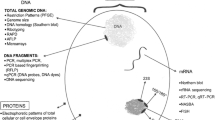Abstract
Enterococcus faecium belonging to the polyclonal subcluster CC17, with a typical ampicillin-resistant E. faecium (AREfm) phenotype, have become prevalent among nosocomial infections around the world. High-density intestinal AREfm colonization could be one of the factors contributing to the successful spread of these pathogens. We aimed to quantify the enterococcal intestinal colonization densities in stool samples from AREfm-colonized and non-colonized patients using fluorescent in situ hybridization (FISH). Stool samples were collected from AREfm-colonized (n = 8) and non-colonized (n = 8) patients. The relative number of Enterococcus faecalis and E. faecium was determined by FISH using specific 16S rRNA probes, while the total amount of bacterial cells was counted by staining the sample with 4′,6-diamidino-2-phenylindole (DAPI). The median bacterial cell numbers in fecal samples, counted by DAPI staining, were 7.7 × 109 and 4.8 × 109 cells/g for AREfm-colonized and non-colonized patients, respectively (p = 0.34). The E. faecium densities in AREfm-colonized patients, accounting for 0.5–7% of all fecal bacterial cells, exceeded E. faecalis levels by over ten-fold. E. faecium was not detected in non-colonized patients. This study demonstrated high E. faecium cell densities in stool samples from patients colonized with AREfm. Increased cell densities may contribute to host-to-host transmission and environmental contamination, facilitating the spread of AREfm in the hospital setting.

Similar content being viewed by others
References
Hidron AI, Edwards JR, Patel J, Horan TC, Sievert DM, Pollock DA, Fridkin SK; National Healthcare Safety Network Team; Participating National Healthcare Safety Network Facilities (2008) NHSN annual update: antimicrobial-resistant pathogens associated with healthcare-associated infections: annual summary of data reported to the National Healthcare Safety Network at the Centers for Disease Control and Prevention, 2006–2007. Infect Control Hosp Epidemiol 29:996–1011. Erratum in: Infect Control Hosp Epidemiol (2009);30:107
European Antimicrobial Resistance Surveillance System (EARSS). EARSS Annual Report 2007. Available at: http://www.rivm.nl/earss. Last accessed 29 June 2010
Willems RJ, van Schaik W (2009) Transition of Enterococcus faecium from commensal organism to nosocomial pathogen. Future Microbiol 4:1125–1135
de Regt MJ, van der Wagen LE, Top J, Blok HE, Hopmans TE, Dekker AW, Hené RJ, Siersema PD, Willems RJ, Bonten MJ (2008) High acquisition and environmental contamination rates of CC17 ampicillin-resistant Enterococcus faecium in a Dutch hospital. J Antimicrob Chemother 62:1401–1406
Hayden MK, Bonten MJ, Blom DW, Lyle EA, van de Vijver DA, Weinstein RA (2006) Reduction in acquisition of vancomycin-resistant enterococcus after enforcement of routine environmental cleaning measures. Clin Infect Dis 42:1552–1560
Harmsen HJ, Raangs GC, He T, Degener JE, Welling GW (2002) Extensive set of 16S rRNA-based probes for detection of bacteria in human feces. Appl Environ Microbiol 68:2982–2990
Waar K, Degener JE, van Luyn MJ, Harmsen HJ (2005) Fluorescent in situ hybridization with specific DNA probes offers adequate detection of Enterococcus faecalis and Enterococcus faecium in clinical samples. J Med Microbiol 54:937–944
Donskey CJ, Chowdhry TK, Hecker MT, Hoyen CK, Hanrahan JA, Hujer AM, Hutton-Thomas RA, Whalen CC, Bonomo RA, Rice LB (2000) Effect of antibiotic therapy on the density of vancomycin-resistant enterococci in the stool of colonized patients. N Engl J Med 343:1925–1932
Pultz NJ, Stiefel U, Subramanyan S, Helfand MS, Donskey CJ (2005) Mechanisms by which anaerobic microbiota inhibit the establishment in mice of intestinal colonization by vancomycin-resistant Enterococcus. J Infect Dis 191:949–956
Lakticová V, Hutton-Thomas R, Meyer M, Gurkan E, Rice LB (2006) Antibiotic-induced enterococcal expansion in the mouse intestine occurs throughout the small bowel and correlates poorly with suppression of competing flora. Antimicrob Agents Chemother 50:3117–3123
Rice LB, Lakticová V, Carias LL, Rudin S, Hutton R, Marshall SH (2009) Transferable capacity for gastrointestinal colonization in Enterococcus faecium in a mouse model. J Infect Dis 199:342–349
Freitas AR, Tedim AP, Novais C, Ruiz-Garbajosa P, Werner G, Laverde-Gomez JA, Cantón R, Peixe L, Baquero F, Coque TM (2010) Global spread of the hyl (Efm) colonization-virulence gene in megaplasmids of the Enterococcus faecium CC17 polyclonal subcluster. Antimicrob Agents Chemother 54:2660–2665
Hopkins MJ, Sharp R, Macfarlane GT (2001) Age and disease related changes in intestinal bacterial populations assessed by cell culture, 16S rRNA abundance, and community cellular fatty acid profiles. Gut 48:198–205
Harthug S, Jureen R, Mohn SC, Digranes A, Simonsen GS, Sundsfjord A, Langeland N, Norwegian Enterococcal Study Group (2002). The prevalence of faecal carriage of ampicillin-resistant and high-level gentamicin-resistant enterococci among inpatients at 10 major Norwegian hospitals. J Hosp Inf 50:145–154
Top J, Willems R, Blok H, de Regt M, Jalink K, Troelstra A, Goorhuis B, Bonten M (2007) Ecological replacement of Enterococcus faecalis by multiresistant clonal complex 17 Enterococcus faecium. Clin Microbiol Infect 13:316–319
Vernon MO, Hayden MK, Trick WE, Hayes RA, Blom DW, Weinstein RA; Chicago Antimicrobial Resistance Project (CARP) (2006) Chlorhexidine gluconate to cleanse patients in a medical intensive care unit: the effectiveness of source control to reduce the bioburden of vancomycin-resistant enterococci. Arch Intern Med 166:306–312
Acknowledgments
This work was partially supported by grants from Ministerio de Sanidad y Consumo of Spain (PI061141), the European Union (LSHE-CT-2007-037410, EAR-LSHM-CT-518152, and TROCAR-223031), and the DeReMicrobiana Project of the Madrid Autonomous Community (CAM-S-SAL-0246-2006). P. Ruiz-Garbajosa was funded by Instituto de Salud Carlos III, Ministry of Health, Spain (Program Río Ortega, CM04/0013). M. Bonten was supported by NWO-VICI 918.76.611. All authors declare no conflicts of interest.
Author information
Authors and Affiliations
Corresponding author
Rights and permissions
About this article
Cite this article
Ruiz-Garbajosa, P., de Regt, M., Bonten, M. et al. High-density fecal Enterococcus faecium colonization in hospitalized patients is associated with the presence of the polyclonal subcluster CC17. Eur J Clin Microbiol Infect Dis 31, 519–522 (2012). https://doi.org/10.1007/s10096-011-1342-7
Received:
Accepted:
Published:
Issue Date:
DOI: https://doi.org/10.1007/s10096-011-1342-7




